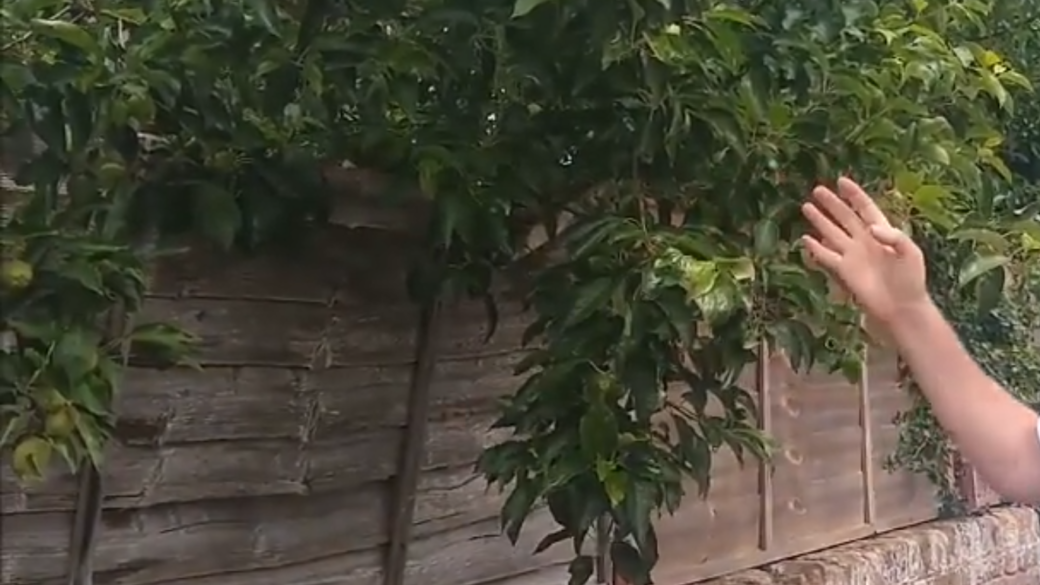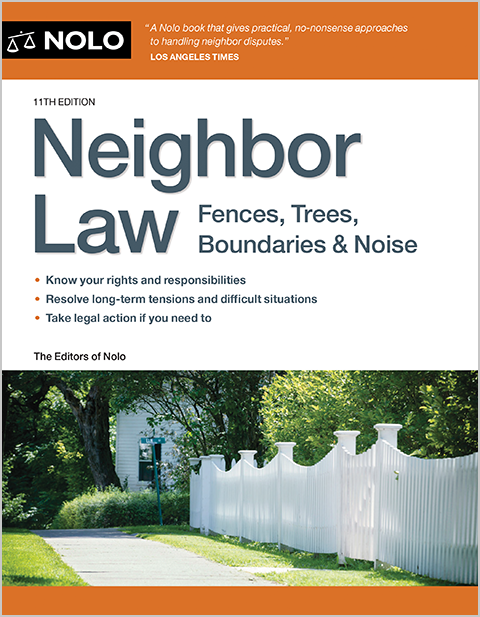Can You Throw Neighbors Tree Branches Back in Their Yard?
Trees provide several benefits to our lives, such as fruits, crops, materials, and aesthetic greenery for our gardens. However, trees must be maintained; if left unattended, the branches can overgrow in different directions or on your neighbor’s property.
These overgrown tree branches could harm nearby structures, obstruct sunlight, and scatter tree waste. You and your neighbor might have an argument about this tree issue.
But what happens when your neighbor’s tree branches fall on your property?
This article will discuss the legal aspects and answer the question, “Can I throw neighbors tree branches back in their yard?”
Is It Legal to Throw Neighbors Tree Branches Back in Their Yard?
If you want to fully understand neighbor law, you should consider purchasing this Nolo Neighbor Law book, which specifically covers boundary lines, and trees that hang over a property line. The last thing you want is for your neighbor dispute to turn into an extensive and expensive lawsuit, so it makes sense to invest in this book which will give you all of the facts at a much cheaper price. The book covers a wide variety of neighbor issues you’re likely to encounter, so you will get more than just one use out of this purchase.
View the Official 2023 edition – Neighbor Law
Overhanging trees on your property can be a nuisance, especially if they fall into your yard. When your neighbors stuff is on your property, you probably want to get rid of them as soon as possible. Before taking action, consider what the law has to say about this matter. In the United States, tree owners are responsible for the maintenance of their trees. They will be held liable if these trees cause a risk or accident to someone else’s property.
If these trees have overhanging branches that extend onto someone else’s property, the property owner has the right to trim off these overgrown branches limited to their property line. But the question is, can I throw neighbors tree branches back in their yard?
Regardless of whether the neighbor’s tree branches fell naturally or were cut by you, it is unlawful to throw them back into their yard. That action is illegal dumping, and the tree owner may take legal action against you. However, if the tree owner agrees, you may return the branches.
Local laws protect tree owners and neighborhoods from potential problems caused by the trees. In the United States and many Western countries, there are existing regulations about trees, such as:
- Regulations pertaining to trees dictate that individuals have the right to trim the limbs and roots of a neighboring tree up to their property boundary.
- Disposing of the severed branches and roots on the tree owner’s premises is not permissible without their approval.
- Those who have pruned branches from a neighboring tree may dispose of them and any fallen leaves as part of routine yard upkeep without needing the tree owner’s consent.
These regulations can vary depending on your location and jurisdiction. That’s why it’s essential to know the contents of your local laws about this matter to avoid disputes with your neighbor.
Can I Throw Neighbors Tree Branches Back in Their Yard in California?
California has one of the most particular tree laws in the USA. So can I throw neighbors tree branches back in their yard in California? The answer is no. It is illegal as your neighbor’s privacy becomes infringed.
Can I Throw Neighbors Tree Branches Back in Their Yard in Washington State?
It is illegal to through your neighbors tree branches back in their yard in Washington State. The best solution may be to politely speak to your neighbor to inform them that your neighbor’s tree branches are in your yard, and they should look at cutting back their tree.
Can I Throw Neighbors Tree Branches Back in Their Yard in Florida?
Throwing your neighbors tree branches back in their yard in Florida is known as illegal dumping, which you will find out more about as you read on. However, in Florida you are legally allowed to trim your neighbor’s tree if it hangs over your property line. The only caveat to this is that you must carry out the trimming on your side of the property line/fence.
What Laws Would I Violate if I Returned My Neighbor’s Trimmed Branches Without Permission?
Since it’s illegal to throw tree branches back onto your neighbor’s property without their consent, doing so may lead you to break laws and have consequences such as:
Illegal Dumping
Your neighbor can sue you for illegal dumping if you throw tree branches back into their yard without their permission. You can be fined up to $10,000 and face jail time for up to six months, and this fine varies for different countries.
Trespassing
In some cases, you may want to trim these overgrown branches from your neighbor that hang over your property, but you did so without permission. You could be charged with trespassing and be fined from $25 to $1000, depending on your state’s regulations.
Punitive Damage
Overgrown branches are a nuisance; however, if you trim these to the extent that they have lost their aesthetic value or damaged the tree, your neighbor could sue you for punitive damages. This is the payment for the damages done to someone else’s property, where you have to compensate for up to three times the value of the property.
What Should I Do Before Taking Action Against My Neighbor’s Tree Branches?
One of the best possible ways to avoid disputes with your neighbor is to communicate and ask for permission before trimming branches and returning them within the vicinity of their property. Your neighbor should be friendly when you talk to them, but sadly a lot of neighbors aren’t friendly anymore.
Another idea is to send a complaint letter to your neighbor to express your concerns about their tree branches.
You can also hire a tree service company to properly inspect and trim branches without breaking any laws. They can perform trimming without compromising the tree’s health and take care of the disposal of tree branches.
How Can I Openly Communicate With My Neighbor About Their Tree Branches?
If you have issues with your neighbor’s tree branches that overhang or fall into your yard, open communication will save you from disputes that may arise if you take actions that violate the rights or property of your neighbor. Here are some suggestions that you can consider if you want to communicate with them:
Have an Avenue for Communication
Inviting your neighbor for a short meeting at your house, a cafe, or visiting them at their house would allow you to raise concerns formally. This also shows that you respect your neighbor because you want to discuss things privately.
Choose a Suitable Time
Most meetings in the US are held during lunch and dinner since most of the people are working. That’s why it’s crucial to choose a time when both you and your neighbor are not busy.
Make a Resolution on the Issue Concerning Tree Branches
You will point out issues with your neighbor; that’s why giving out solutions that work best for you will save you a lot of time planning what actions to take.
What Solutions Can I Work Out With My Neighbor About the Tree Branches Disposal?
If you wish to take action relative to the tree branches from your neighbor’s tree that fall in your yard, you might consider the following:
Contact Local Waste Disposal Service
In some places in the US, it is illegal to dispose of tree branches, leaves, and grass clippings in household trash. That’s why it’s essential to first contact a local waste disposal service to dispose of the tree branches correctly.
Look for a Community Compost
Composting is the best way to dispose of materials without harming the environment. That’s why in the states, few communities offer community compost that is accessible for public use.
Donating Tree Branches to Upcycling Community
Innovative ways of reusing waste to create a new, high-quality product are being recommended to everyone. It’s cost-efficient and nature-friendly; through this, you can make use of your tree branches instead of disposing of them.
How Can I Safely Trim My Neighbor’s Overgrown Tree Branches?
Overgrown tree branches can be a serious matter, especially if these branches affect your property. You are allowed to trim off the excess branches that reside on your property; however, you have to do it safely without damaging the aesthetic features of the tree or its structure. Or else your neighbor has the right to sue you for any damage you might cause.
Choose the Right Tools
Trimming trees might sound simple, but it’s essential to use the right cutting tools in order to prevent any damage from the tree’s growth. Here are some tools that you can use for safe trimming:
Pruning Shears
This is a handy tool that allows you to trim thin branches up to an inch in diameter. You can make clean cuts to pare back limbs and grow.
Lopping Shears
The tool’s model can cut branches up to 1 1/2 to 2 inches in diameter. Loppers’ large handles allow two hands to trim branches which is ideal for thicker branches.
Bow Saw
Bow saws chop branches easier than pruning saws. Rocking the instrument requires less strength in cutting strong branches and limbs.
Long Reach Tree Pruner
The long-reach tree pruner helps people cut tree limbs above their heads. It is also a great lightweight cutter. This is the best choice for trimming high branches up to 7ft without much effort.
Doing things by yourself can take a lot of time and effort; instead, you can hire a professional tree service company to do the job for you. They are skilled in safely trimming branches and disposing of them without violating any tree laws.
Who Is Responsible for the Overgrown Trees on My Property?
You might be wondering who’s responsible for the trees that fall into your yard, but the law mandates that the owner is responsible for the tree. The owner is also responsible for the maintenance costs, including trimmings and inspections to determine whether the roots or branches may cause a potential danger to the neighborhood or someone’s well-being.
The owner is also held liable if the tree causes damage to someone’s property or causes an accident. But in some cases, these accidents may be caused by natural phenomena such as typhoons and hurricanes. If this is the case, the two parties could agree to split the cost of fixing the damaged property. The best way to make the agreement legal and official is to have an attorney draft a cost-sharing agreement contract and have it notarized.
Where Can I Seek Help About My Neighbor’s Overgrown Tree?
If you’re concerned about being unsure of what to do about the overgrown trees that extend to your yard, having and consulting an expert is one of the easiest ways to resolve the issue, and here’s how:
Home Owner’s Association
In the United States, every homeowner’s association has different rules and guidelines to maintain a safe and peaceful neighborhood. You can reach out to your neighborhood’s association and consult about the dos and don’ts of handling your neighbor’s tree branches that fell on your property line.
When there are problems with your neighbor about trees, the homeowner’s association can mediate to solve the problem without calling the authorities.
Municipal Office
Local laws from every municipality mandate that the tree owner is responsible for the maintenance, care, and ensuring that the trees do not pose a risk for accident or invade someone else’s property.
If you want to solve your problems with overgrown trees, you should talk to your local municipality to make sure you follow all the laws. The municipal office can also help mediate matters about the overgrown trees with your neighbor.
Real Estate Firm
For conflicts involving trees, seeking help from an attorney with the knowledge and expertise of handling issues would be a great option if it concerns your property. A real estate attorney can legally provide solutions and mediate between both parties in advocating for negotiations to fix the tree issue.
Having someone to help or mediate with your concerns is essential; it allows you to avoid arguments with your neighbor and ensures that a better solution that works for both parties will be found.
What Are the Common Misconceptions About Trees and Properties?
You might think that trees are just simple trees, but no. Trees are also properties that are covered and protected by different laws. Here are some common misconceptions that you should know:
It is okay to throw neighboring tree branches back into their yard.
Believing that since your neighbor is the tree’s owner, it is OK to return the tree’s fallen branches to their land. But according to the law, it is illegal to throw tree branches back at your neighbor. You can be charged with illegal dumping for doing so.
It is okay to trim down my neighbor’s tree branches that extend into my property.
It is okay to trim down your neighbor’s tree branches that extend onto your property. However, you have to do it safely and responsibly. Most state laws suggest that you can trim branches within your property line, but you cannot go beyond it. You have to make sure that it does not damage the structure and health of the tree.
Trees in the forest don’t need maintenance, and neither does my tree.
The tree is your property, and it is your responsibility to take care of it and ensure that it does not harm someone else’s property or well-being. You have to make sure that the branches do not overhang to the extent that they affect your neighbor’s home. You have to maintain it’s health and safety to avoid bad relations with your neighbor.
I can plant trees anywhere in my yard since it’s on my property.
You can indeed plant trees anywhere on your property, but to err on the side of caution, you have to consider that while your trees grow, they could affect your neighbor. Overgrown trees near the fence tend to overhang and blow leaves in various directions.
That’s why it’s also essential to choose a tree species for planting that doesn’t overgrow, such as:
-
Ornamental Trees (Japanese Maple, Crape Myrtle, Star Magnolia)
-
Fruit Trees (Cornelian cherry dogwood, Dwarf Apple Tree, Adams crabapple)
-
Shade Trees (Amur Maple, Trident Maple, Chinese Pistache)
-
Shrubs (Glossy Abellia, Gardenia, Camellias)
Final Words
In conclusion, trees are good for us in many ways, but if they aren’t taken care of properly, they can cause problems between neighbors. An overgrown tree in your neighbor’s yard that leans into your property isn’t ideal.
It is important to understand the legal aspects of dealing with overgrown tree branches on your property as well as the potential consequences of returning these branches to your neighbor’s yard without permission.
Communication is the key to solving problems with trees, and it’s important to know the local laws and rules to avoid legal problems. Before you do anything about your neighbor’s tree branches, talk to them about it and find other ways to get rid of or trim them.
Remember, maintaining good relations with your neighbors and ensuring the health and safety of trees on your property will contribute to a harmonious and pleasant living environment for everyone.



